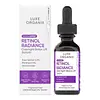What's inside
What's inside
 Key Ingredients
Key Ingredients

 Benefits
Benefits

 Concerns
Concerns

 Ingredients Side-by-side
Ingredients Side-by-side

Water
Skin ConditioningPanthenol
Skin ConditioningButylene Glycol
HumectantCaprylic/Capric Triglyceride
MaskingSodium PCA
HumectantPropanediol
SolventAmmonium Polyacryloyldimethyl Taurate
Emulsion StabilisingHydroxyacetophenone
Antioxidant1,2-Hexanediol
Skin ConditioningDimethyl Isosorbide
SolventPentylene Glycol
Skin ConditioningNiacinamide
SmoothingResveratrol
AntioxidantLactobacillus/Soymilk Ferment Filtrate
Skin ConditioningPolysorbate 20
EmulsifyingRetinol
Skin ConditioningAllantoin
Skin ConditioningPhenoxyethanol
PreservativeBHT
AntioxidantBHA
AntioxidantWater, Panthenol, Butylene Glycol, Caprylic/Capric Triglyceride, Sodium PCA, Propanediol, Ammonium Polyacryloyldimethyl Taurate, Hydroxyacetophenone, 1,2-Hexanediol, Dimethyl Isosorbide, Pentylene Glycol, Niacinamide, Resveratrol, Lactobacillus/Soymilk Ferment Filtrate, Polysorbate 20, Retinol, Allantoin, Phenoxyethanol, BHT, BHA
Water
Skin ConditioningGlycerin
HumectantAlcohol
AntimicrobialDipropylene Glycol
HumectantButylene Glycol
HumectantPEG/PPG/Polybutylene Glycol-8/5/3 Glycerin
HumectantNiacinamide
SmoothingHydroxyethylpiperazine Ethane Sulfonic Acid
BufferingBis-PEG-18 Methyl Ether Dimethyl Silane
Emollient3-O-Ethyl Ascorbic Acid
Skin ConditioningIsononyl Isononanoate
EmollientBHT
AntioxidantLinalool
PerfumingGeraniol
PerfumingParfum
MaskingSalicylic Acid
MaskingSodium Citrate
BufferingSodium Hyaluronate
HumectantPhenoxyethanol
PreservativePhenylethyl Resorcinol
AntioxidantAdenosine
Skin ConditioningAmmonium Polyacryloyldimethyl Taurate
Emulsion StabilisingTocopheryl Acetate
AntioxidantDisodium EDTA
Limonene
PerfumingHydrogenated Lecithin
EmulsifyingCitric Acid
BufferingCitrus Limon Fruit Extract
MaskingCitrus Junos Fruit Extract
Skin ConditioningXanthan Gum
EmulsifyingMaltodextrin
AbsorbentAcetyl Trifluoromethylphenyl Valylglycine
Skin ConditioningOxothiazolidinecarboxylic Acid
Skin ConditioningBenzyl Salicylate
PerfumingBenzyl Alcohol
PerfumingWater, Glycerin, Alcohol, Dipropylene Glycol, Butylene Glycol, PEG/PPG/Polybutylene Glycol-8/5/3 Glycerin, Niacinamide, Hydroxyethylpiperazine Ethane Sulfonic Acid, Bis-PEG-18 Methyl Ether Dimethyl Silane, 3-O-Ethyl Ascorbic Acid, Isononyl Isononanoate, BHT, Linalool, Geraniol, Parfum, Salicylic Acid, Sodium Citrate, Sodium Hyaluronate, Phenoxyethanol, Phenylethyl Resorcinol, Adenosine, Ammonium Polyacryloyldimethyl Taurate, Tocopheryl Acetate, Disodium EDTA, Limonene, Hydrogenated Lecithin, Citric Acid, Citrus Limon Fruit Extract, Citrus Junos Fruit Extract, Xanthan Gum, Maltodextrin, Acetyl Trifluoromethylphenyl Valylglycine, Oxothiazolidinecarboxylic Acid, Benzyl Salicylate, Benzyl Alcohol
 Reviews
Reviews

Ingredients Explained
These ingredients are found in both products.
Ingredients higher up in an ingredient list are typically present in a larger amount.
Ammonium Polyacryloyldimethyl Taurate is a polymer made from ammonium salts. It helps add stability and texture to a product. This ingredient is stable over a wide pH range.
Due to its ability to absorb water, it can help thicken the texture of a product. As an emulsion stabilizer, this ingredient is stabilizes other ingredients to create a consistent texture.
According to a manufacturer, it helps create a "smooth, light and fresh" texture.
Learn more about Ammonium Polyacryloyldimethyl TaurateBHT is a synthetic antioxidant and preservative.
As an antioxidant, it helps your body fight off free-radicals. Free-radicals are molecules that may damage your skin cells.
As a preservative, it is used to stabilize products and prevent them from degrading. Specifically, BHT prevents degradation from oxidation.
The concerns related to BHT come from oral studies; this ingredient is currently allowed for use by both the FDA and EU.
However, it was recently restricted for use in the UK as of April 2024.
Learn more about BHTButylene Glycol (or BG) is used within cosmetic products for a few different reasons:
Overall, Butylene Glycol is a safe and well-rounded ingredient that works well with other ingredients.
Though this ingredient works well with most skin types, some people with sensitive skin may experience a reaction such as allergic rashes, closed comedones, or itchiness.
Learn more about Butylene GlycolNiacinamide is a multitasking form of vitamin B3 that strengthens the skin barrier, reduces pores and dark spots, regulates oil, and improves signs of aging.
And the best part? It's gentle and well-tolerated by most skin types, including sensitive and reactive skin.
You might have heard of "niacin flush", or the reddening of skin that causes itchiness. Niacinamide has not been found to cause this.
In very rare cases, some individuals may not be able to tolerate niacinamide at all or experience an allergic reaction to it.
If you are experiencing flaking, irritation, and dryness with this ingredient, be sure to double check all your products as this ingredient can be found in all categories of skincare.
When incorporating niacinamide into your routine, look out for concentration amounts. Typically, 5% niacinamide provides benefits such as fading dark spots. However, if you have sensitive skin, it is better to begin with a smaller concentration.
When you apply niacinamide to your skin, your body converts it into nicotinamide adenine dinucleotide (NAD). NAD is an essential coenzyme that is already found in your cells as "fuel" and powers countless biological processes.
In your skin, NAD helps repair cell damage, produce new healthy cells, support collagen production, strengthen the skin barrier, and fight environmental stressors (like UV and pollution).
Our natural NAD levels start to decline with age, leading to slower skin repair, visible aging, and a weaker skin barrier. By providing your skin niacinamide, you're recharging your skin's NAD levels. This leads to stronger, healthier, and younger looking skin.
Another name for vitamin B3 is nicotinamide. This vitamin is water-soluble and our bodies don't store it. We obtain Vitamin B3 from either food or skincare. Meat, fish, wheat, yeast, and leafy greens contain vitamin B3.
The type of niacinamide used in skincare is synthetically created.
Learn more about NiacinamidePhenoxyethanol is a preservative that has germicide, antimicrobial, and aromatic properties. Studies show that phenoxyethanol can prevent microbial growth. By itself, it has a scent that is similar to that of a rose.
It's often used in formulations along with Caprylyl Glycol to preserve the shelf life of products.
Water. It's the most common cosmetic ingredient of all. You'll usually see it at the top of ingredient lists, meaning that it makes up the largest part of the product.
So why is it so popular? Water most often acts as a solvent - this means that it helps dissolve other ingredients into the formulation.
You'll also recognize water as that liquid we all need to stay alive. If you see this, drink a glass of water. Stay hydrated!
Learn more about Water